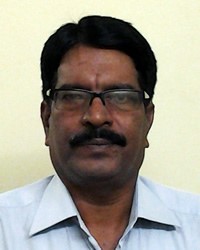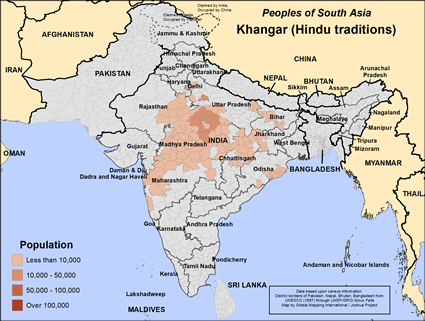Khangar (Hindu traditions) in India

Photo Source:
Anonymous
|

Map Source:
People Group data: Omid. Map geography: UNESCO / GMI. Map Design: Joshua Project.
|
| People Name: | Khangar (Hindu traditions) |
| Country: | India |
| 10/40 Window: | Yes |
| Population: | 344,000 |
| World Population: | 344,000 |
| Primary Language: | Hindi |
| Primary Religion: | Hinduism |
| Christian Adherents: | 0.00 % |
| Evangelicals: | 0.00 % |
| Scripture: | Complete Bible |
| Ministry Resources: | Yes |
| Jesus Film: | Yes |
| Audio Recordings: | Yes |
| People Cluster: | South Asia Dalit - other |
| Affinity Bloc: | South Asian Peoples |
| Progress Level: |
|
Introduction / History
The Khangar community is a clan of Indian origin. They are an ancient Kshtriya clan. The word "Khangar" means" sword bearer." They are classed as a scheduled caste in some states of India and OBC in others.
Where Are they Located?
Khangar people are located in 10 states of India, with Madya Pradesh containing the highest concentration.
What Are Their Lives Like?
Khangar speak local dialects, Hindi, and write in Devangari.
The main work of the Khangar is agriculture. In Madya Pradesh, weaving has been the primary work though many have turned to other things, as cloth and cosmetic selling, manufacturing and tailor work, yielding higher profits. Most Khangar own some land, but in Bihar they usually have no land, and work as farm laborers, government workers, and construction laborers.
They have political leaders at village level. Khangar people have traditional caste councils. They deal with lesser civil and criminal matters.
Literacy is lower than the national average, particularly in Bihar where girls are not sent to school. They plan their families, use modern medicines, and development programs, except in Bihar.
They non-vegetarian but do not eat beef because of their Hindu religion. They also eat wheat, rice, seasonal vegetables, milk products, and fruit.
They marry partners from their own groups. Marriages are arranged by relatives. Adult marriages are more common, but child marriages are common in Rajasthan.
What Are Their Beliefs?
Khangar people are mostly Hindu. They worship family, clan and regional gods and goddesses, and their ancestors. They bring in sorcerers and witchdoctors, whom they believe will expel evil spirits. Brahmin priests cremate the dead, and they have birth and death pollution periods. They celebrate Hindu festivals.
What Are Their Needs?
Central India remains a pioneer mission field, but outreach, response, and persecution are increasing, reflecting persecution levels.
Khangar people are generally poor and have many physical and spiritual needs.
Their greatest need is for their Savior.
Although many visual and audio Bible resources are available in the Hindi language, fear blocks opportunities among these people.
Prayer Points
Pray that Khangar people will be liberated by God's Holy Spirit from the many ties that bind them, and false deities that weigh them down, causing them to live in fear.
Pray that as they celebrate many Hindu festivals, the Holy Spirit of the one true God will enable them to celebrate His reconciliation – His full payment of the penalty for their sins.